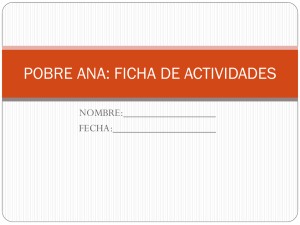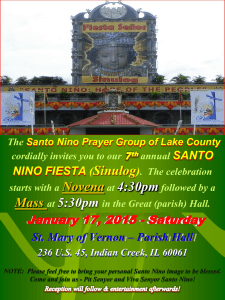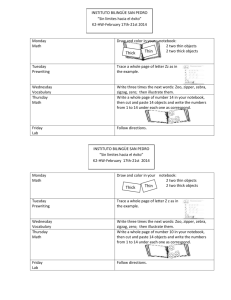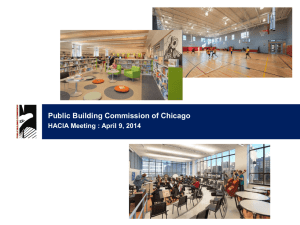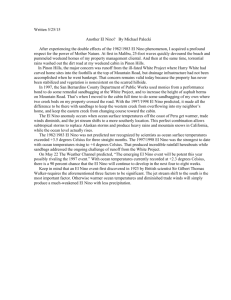Lesson Starters – Primary Spanish - El camino de la escuela About
advertisement
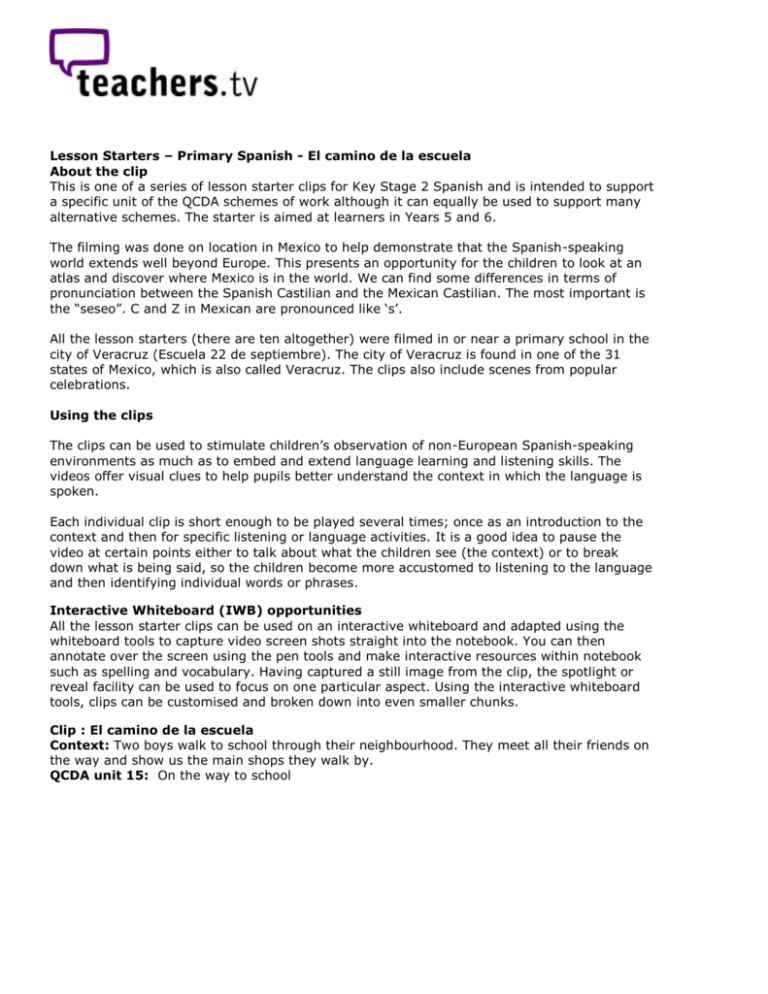
Lesson Starters – Primary Spanish - El camino de la escuela About the clip This is one of a series of lesson starter clips for Key Stage 2 Spanish and is intended to support a specific unit of the QCDA schemes of work although it can equally be used to support many alternative schemes. The starter is aimed at learners in Years 5 and 6. The filming was done on location in Mexico to help demonstrate that the Spanish-speaking world extends well beyond Europe. This presents an opportunity for the children to look at an atlas and discover where Mexico is in the world. We can find some differences in terms of pronunciation between the Spanish Castilian and the Mexican Castilian. The most important is the “seseo”. C and Z in Mexican are pronounced like ‘s’. All the lesson starters (there are ten altogether) were filmed in or near a primary school in the city of Veracruz (Escuela 22 de septiembre). The city of Veracruz is found in one of the 31 states of Mexico, which is also called Veracruz. The clips also include scenes from popular celebrations. Using the clips The clips can be used to stimulate children’s observation of non-European Spanish-speaking environments as much as to embed and extend language learning and listening skills. The videos offer visual clues to help pupils better understand the context in which the language is spoken. Each individual clip is short enough to be played several times; once as an introduction to the context and then for specific listening or language activities. It is a good idea to pause the video at certain points either to talk about what the children see (the context) or to break down what is being said, so the children become more accustomed to listening to the language and then identifying individual words or phrases. Interactive Whiteboard (IWB) opportunities All the lesson starter clips can be used on an interactive whiteboard and adapted using the whiteboard tools to capture video screen shots straight into the notebook. You can then annotate over the screen using the pen tools and make interactive resources within notebook such as spelling and vocabulary. Having captured a still image from the clip, the spotlight or reveal facility can be used to focus on one particular aspect. Using the interactive whiteboard tools, clips can be customised and broken down into even smaller chunks. Clip : El camino de la escuela Context: Two boys walk to school through their neighbourhood. They meet all their friends on the way and show us the main shops they walk by. QCDA unit 15: On the way to school TRANSCRIPT Nino 1 Nino 2 Mamá Nino 2 Nino 1 Nino 2 Nino 1 Nino2 Nino Nino Nino Nino 1 2 1 2 Nino 1 Nino 2 El camino de la escuela Langua ge element s S al g o d e m i ca sa ¡Hey! .... ¿Cómo te vas a la escuela? Primero salgo de mi casa y doblo a la derecha ¡Te apuras y cierras la puerta! Voy con mi mamá y mis dos hermanas. Ya voy mama, ¡espérenme! Y ¿qué haces después? Sigo caminando hacia la esquina y me encuentro a mis amigas. Después cruzo la calle y doblo hacia la izquierda. Me encuentro con mi amigo Alfredo y doblo hacia la derecha. ¿Y pasas por unas tiendas? Sí, paso por dos, una que está en la esquina y la y la frutería, donde venden mangos, plátanos, manzanas melones. Y ¿qué fruta te gusta más? La fruta que me gusta más es la manzana. d ¿Y qué haces entonces? o Sigo caminando todo recto. Cinco minutos más y doblo hacia la bl izquierda. Llegando a la esquina, cruzo la calle. Ahí, se encuentra o un teléfono donde doblo hacia la derecha. A doscientos metros a después, doblo hacia la izquierda y por fin llego al colegio. la Es que no entiendo. ¡Repite por favor! d ¡Ohhh! er echa / sigo caminando hacia la esquina / cruzo la calle / doblo hacia la izquierda / doblo hacia la derecha / todo recto Suggested activities Ask children to draw maps of their route to school, annotating these with a list of places they pass. This could include distance travelled, walking to school with/without parents, types of school bags, what you see en route like shops and amenities. They then compare and contrast their journey to school with the boys in the clip. Copy, print and cut into sets of cards (one per pair of pupils) the following directions. As children watch the boy talking about his way to school, they should put the cards in the order of his journey. To make the activity more challenging, ask the children to watch the clip in 2-3 shorter sections and tell them not to touch the cards while the clip is playing. Once the programme is paused, pairs of children can arrange the cards – but stop again when the next section is played and so on. Primero salgo de mi casa y doblo a la derecha. Sigo caminando hacia la esquina y me encuentro a mis amigas. Sigo caminando hacia la esquina y me encuentro a mis amigas. Sigo caminando hacia la esquina y me encuentro a mis amigas. Después cruzo la calle y doblo hacia la izquierda. Me encuentro con mi amigo Alfredo y doblo hacia la derecha. Sigo caminando todo recto. Cinco minutos más y doblo hacia la izquierda. Llegando a la esquina, cruzo la calle. Ah se encuentra un teléfono donde doblo hacia la derecha. A doscientos metros después, doblo hacia la izquierda y por fin llego al colegio. Children can also use dictionaries to list the shops they find in their way to school and list at least 5 items they can buy in those shops. e.g. La frutería donde venden mangos, plátanos, manzanas, melons. The consultant for the programme was Jenny Carpenter, MFL Adviser, London Borough of Barking and Dagenham.
